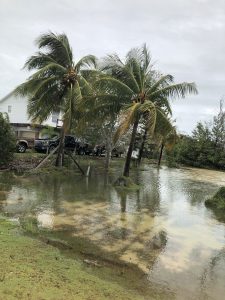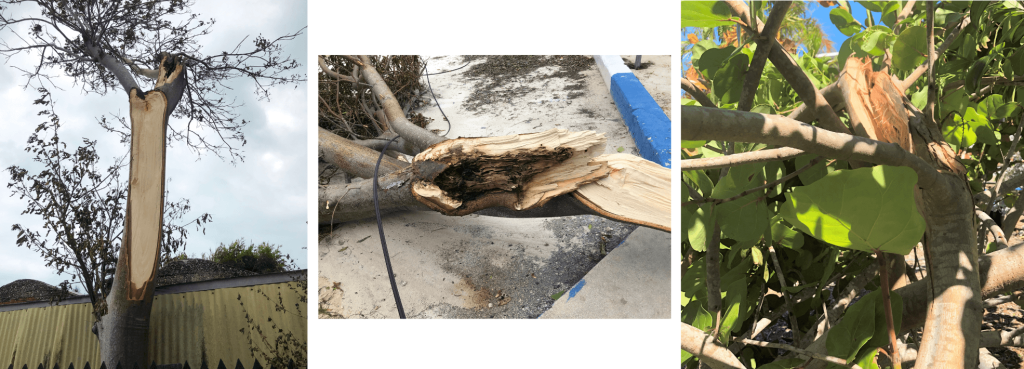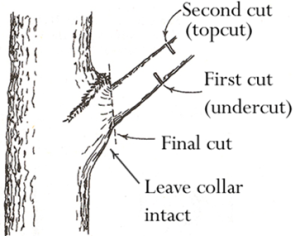Para acceder a esta comunicación en español, por favor utilice este enlace.
Hurricane Ian made an impact as it passed west of the Keys. Though we were spared the worst, strong hurricane-force wind gusts and fast-moving storm surge caused significant damage in some areas. Yards and homes were flooded with saltwater and trees were broken apart or toppled. Now comes the decisions on how to mitigate this damage.
Saltwater Flooding
The best way to help plants survive, that have been flooded with saltwater, is to get fresh water to the roots (once saltwater subsides, and when it is safe to do so). Use the dripline of the canopy as a guide on how far out to drench with fresh water. Damage to plants might not be known initially and could take a couple weeks to see the effects. Do not rush to prune or remove these plants. Allow plants to flush out with new growth and use that as a guide for removing any dieback.

Likewise, plants in high-wind impacted areas might have leaf burn or the leaves were removed entirely by strong winds. Many of these plants will likely drop leaves and begin to push out new foliage. Again, patience is your friend. Do not rush to remove any of the leaves that are still green, even if areas of the leaf tissue may be brown or black. Removing any additional foliage will only add stress to the plant.

Tree Mitigation
Trees that have suffered damage in a storm can be uprighted and restored with corrective measures when:
- Only small branches are dead or broken.
- Leaning or fallen trees are young or recently planted, usually under 4” in diameter.
- Trees that have good decay resistance and suffer only some large limb breakage.
However, removal of canopy trees may be the best option under the following conditions:
- The lower trunk is cracked or broken.
- A very large limb has split from the tree to expose additional structural issues.
- Major roots are severed or broken on mature trees.
- The tree is leaning towards a target like a home, building, or roadway, etc.
- The remaining tree has a very poor structure that is highly susceptible to breakage.
- Most of the canopy is broken with large diameter limbs that will be difficult to restore.

Safety comes first! Tree work can be very dangerous. So the general rule of thumb is anything you cannot handle from the ground, should be done by a professional. They have the right equipment like bucket trucks and climbing gear. Also, tree care professionals understand the nuances of working in the different types of trees. For instance, gumbo limbos are extremely slippery because of their peeling bark. It is very easy for someone to slip and fall and the danger is increased when carrying heavy pruning equipment, like chainsaws.
Proper Pruning
Trees do not heal from damage, including pruning. The best defense they have is to compartmentalize or “wall-off” the damage from potential invading pathogens and insects. Improper pruning can weaken the tree and cause it to decline further and ultimately contribute to death from secondary invading organisms.
- Always make good pruning cuts to encourage compartmentalization and strong branch attachment.
- Illegal practices such as hat-racking and stub cuts can contribute to weak branch attachment and cause the tree to become a hazard in future storms.
- Use the three-step pruning guideline when cutting large limbs (a more thorough explanation is provided in the links below).

Fruit Trees
- Fruit trees that have been uprooted may need sun protection until they can be stood back up because of sun exposure and overheating to areas of the tree that were previously shaded.
- Resetting trees larger than 15 feet will require heavy equipment and might not be recommended in a home landscape, especially if most of the roots were severed and it’s in the small yard where there are nearby structures like a house or vehicle.
- If a tree has gone down in a previous storm and has been uprooted a second time, removal is the best option.
- Large fruit trees like avocado and mango should be planted 25 feet or more away from any structures. However, many landscapes in the keys are small, and so regular pruning to reduce the height of the tree and open up the canopy for better wind flow will greatly reduce the chance of them toppling in a storm. Mature avocado trees can be maintained at 10 to 15 feet and 6 to 15 feet for mangos.
- Additional recommendations are including in the link in the references section.
Each landscape situation is unique and you may have more questions than answers. Contact your local County Extension Office for additional help. Here in Monroe County, you can call (305) 292-4501 or contact our Master Gardener Volunteers directly at mastergardener@monroecounty-fl.gov.
Where to get more information:
Assessing Damage and Restoring Trees After a Hurricane
https://sfyl.ifas.ufl.edu/media/sfylifasufledu/miami-dade/documents/disaster-preparation/hurricane-and-disaster/Assessing-Damage-and-Restoring-Trees-After-a-Hurricane-Gilman.pdf
Preparation for and Recovery From Hurricanes for Tropical Fruit Trees in the South Florida Home Landscape
https://edis.ifas.ufl.edu/publication/HS322
Is My Tree Safe? Recognizing Conditions that Increase the Likelihood of Tree Failure
https://edis.ifas.ufl.edu/publication/EP507
 4
4
